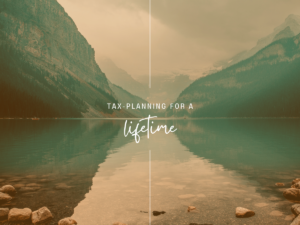
By Steve Lowrie, CFA
Special to Financial Independence Hub
I would be remiss if I didn’t dedicate at least one post in my “Play It Again, Steve” series to everyone’s least favourite, but still significant topic: taxes.
It’s a good thing there’s no tax on writing about tax planning; if there were, I would surely owe a lot.
Here are six timeless techniques for reducing your lifetime tax load:
1. Fill up your tax-sheltered investment accounts.
Taxes primarily exist to raise money for government operations, but they also are often structured to encourage us to spend and save in particular ways. For example, there are:
- Tax-favoured Registered Education Savings Plans (RESPs) that make it easier to save for your kids’ education,
- Tax-Free Savings Accounts (TFSAs) to set aside money tax-free throughout your lifetime,
- Registered Retirement Savings Plans (RRSPs) to reduce taxes and save for future retirement lifestyle needs, and
- new for 2023, the tax-free First Home Savings Account (FHSA).
If you’re saving anyway, you might as well take advantage of any available tax breaks for doing so. Each tax-sheltered, or “registered” account comes with different rules on whether the money goes in pre- or post-tax, and whether it comes back out as taxable or tax-free income. But all of them share a powerful, often overlooked advantage: Investments in all registered accounts grow tax-free.
So, fill up those registered accounts. Also, be sure to invest any of it you’re not going to need for a decade or more. The snowball effect of tax-sheltered investing should help you accumulate significantly more after-tax wealth than if it’s just sitting in cash.
2. Invest tax efficiently in and among your registered and taxable accounts.
There are endless ways to invest more tax-efficiently; here are a few of the greatest hits:
How you invest: Since you only incur taxes when you sell a holding, an obvious rule of thumb is to avoid unnecessary taxable trading. Build a durable portfolio you can stick with through thick and thin, and avoid chasing hot and cold stock picks and market conditions.
With whom you invest: Especially in your taxable accounts, avoid funds whose managers are actively picking stocks or timing the market. You won’t directly see their extra, unnecessary trades. But they’ll show up at tax time in the form of taxable capital gain distributions to unit holders: i.e., you. Worse, you could end up owing taxes on those invisible gains, whether the fund goes up or down in value. There are few more unpleasant surprises for an investor than a big, year-end tax bill on a fund that’s lost value.
Where you invest (asset location): Hold your relatively tax-inefficient assets (such as bonds and REITs) in tax-sheltered accounts, where the inefficiencies don’t matter as much. Hold your relatively tax-efficient assets (such as broad stock funds) in taxable accounts.
3. Remember, not all tax rates are the same. Aim for the less costly ones.
For personal taxable accounts and investment holdcos, some taxes cost less than others. Your most tax-efficient investing income comes in the form of capital gains, since they are taxed at lower rates than other sources such as interest or dividends. This, combined with asset location considerations, is another reason to avoid loading up on dividend stocks as a strategy for generating an income stream in retirement.
Don’t believe me? Consider these 2023 combined tax rates for Ontario:
| Taxable Income Source | 2023 Combined Tax Rate |
|---|---|
| Interest and other income | 53.53% |
| Eligible dividends (mostly Cdn. companies) | 39.34% |
| Capital gains | 26.76% |
4. Harvest tax losses to offset taxable gains.
In your non-registered accounts, you can take advantage of market downturns to incur tax losses to offset taxable gains. Tax-loss harvesting can be worthwhile, but it’s worth doing in alliance with a financial professional, so you do it effectively, and without violating the CRA’s rules on reporting capital losses. Basically, when taxable holdings are worth less than you paid for them — but over the long run you expect them to grow — you can:
- Sell depreciated taxable positions to generate capital losses, and use them to offset current or future taxable gains on your tax returns.
- Promptly buy a similar (but not identical!) position, to remain invested in the market as planned.
- Eventually (optionally), reinvest in the original position, to restore your portfolio to its original mix.
5. Focus on total taxes instead of one year at a time.
Few, if any of us can avoid paying income taxes forever. Rather than trying to pay the lowest taxes each year, you may be able to reduce your overall tax obligations by considering when and how to efficiently pay taxes over your lifetime. For example, in otherwise low-income years, you may intentionally incur some taxable gains, so you’ll be less likely to face those gains in years when your marginal rates are higher. It’s similar in philosophy to total-return investing, where you pay more attention to your portfolio-wide risk/return profile, instead of individual stock picks or market climates.
6. Take advantage of advanced tax-planning techniques.
There are plenty of other ways to minimize taxes and maximize after-tax wealth.
- Investment holdco owners: To manage the impact of business income on your personal taxes, you can turn to corporate income planning (such as when to take a salary vs. a dividend), and to structures such as holding companies.
- Families building generational wealth: To fund more tax-efficient wealth transfers, you may find family trusts and/or targeted insurance applications make good sense.
- Retirees: As you spend down assets from your registered and unregistered accounts, you can step up your planning on which assets to withdraw from where, in what order.
- Charitably inclined: Tax breaks abound when you’re deliberate about supporting your favourite non-profit causes. For example, instead of waiting until after you die, you may find even greater personal satisfaction and tax-efficient value in giving away some of your wealth while you’re still around.
Tax Planning for Life
To recap, it’s more rewarding than most investors realize to plan for both the immediate and long-range impact of when, how, and where to incur taxable income. Managing families’ taxable parts to enhance their total wealth as a whole is built into our holistic financial planning at Lowrie Financial. Please be in touch if you’d like to find out what that level of tax planning would look like for you and your lifetime financial well-being.
 Steve Lowrie holds the CFA designation and has 25 years of experience dealing with individual investors. Before creating Lowrie Financial in 2009, he worked at various Bay Street brokerage firms both as an advisor and in management. “I help investors ignore the Wall and Bay Street hype and hysteria, and focus on what’s best for themselves.” This blog originally appeared on his site on April 10, 2023 and is republished here with permission.
Steve Lowrie holds the CFA designation and has 25 years of experience dealing with individual investors. Before creating Lowrie Financial in 2009, he worked at various Bay Street brokerage firms both as an advisor and in management. “I help investors ignore the Wall and Bay Street hype and hysteria, and focus on what’s best for themselves.” This blog originally appeared on his site on April 10, 2023 and is republished here with permission.


